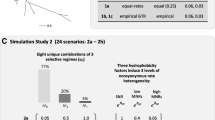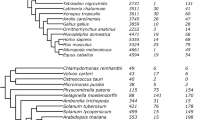Abstract
Functional shifts during protein evolution are expected to yield shifts in substitution rate, and statistical methods can test for this at both codon and amino acid levels. Although methods based on models of sequence evolution serve as powerful tools for studying evolutionary processes, violating underlying assumptions can lead to false biological conclusions. It is not unusual for functional shifts to be accompanied by changes in other aspects of the evolutionary process, such as codon or amino acid frequencies. However, models used to test for functional divergence assume these frequencies remain constant over time. We employed simulation to investigate the impact of non-stationary evolution on functional divergence inference. We investigated three likelihood ratio tests based on codon models and found varying degrees of sensitivity. Joint effects of shifts in frequencies and selection pressures can be large, leading to false signals for positive selection. Amino acid-based tests (FunDi and Bivar) were also compromised when several aspects of the substitution process were not adequately modeled. We applied the same tests to a core genome “scan” for functional divergence between light-adapted ecotypes of the cyanobacteria Prochlorococcus, and carried out gene-specific simulations for ten genes. Results of those simulations illustrated how the inference of functional divergence at the genomic level can be seriously impacted by model misspecification. Although computationally costly, simulations motivated by data in hand are warranted when several aspects of the substitution process are either misspecified or not included in the models upon which the statistical tests were built.


Similar content being viewed by others
References
Anisimova M, Yang Z (2007) Multiple hypothesis testing to detect lineages under positive selection that affects only a few sites. Mol Biol Evol 24:1219–1228
Aris-Brosou S, Bielawski JP (2006) Large-scale analyses of synonymous substitution rates can be sensitive to assumptions about the process of mutation. Gene 378:58–64
Bao L, Gu H, Dunn KA, Bielawski JP (2008) Likelihood-based clustering (LiBaC) for codon models, a method for grouping sites according to similarities in the underlying process of evolution. Mol Biol Evol 25:1995–2007
Bay RA, Bielawski JP (2011) Recombination detection under evolutionary scenarios relevant to functional divergence. J Mol Evol 73:273–286
Bielawski JP, Yang Z (2004) A maximum likelihood method for detecting functional divergence at individual codon sites, with application to gene family evolution. J Mol Evol 59:121–132
Chang BSW, Campbell DL (2000) Bias in phylogenetic reconstruction of vertebrate rhodopsin sequences. Mol Biol Evol 17:1220–1231
Chisholm SW, Olson RJ, Zettler ER, Goericke R, Waterbury JB, Welschmeyer NA (1988) A novel free-living prochlorophyte abundant in the oceanic euphotic zone. Nature 334:340–343
Dufresne A, Salanoubat M, Partensky F, Artiguenave F, Axmann IM, Barbe V, Duprat S, Galperin MY, Koonin EV, Le Gall F et al (2003) Genome sequence of the cyanobacterium Prochlorococcus marinus SS120, a nearly minimal oxyphototrophic genome. Proc Natl Acad Sci USA 100:10020–10025
Fletcher W, Yang Z (2009) INDELible: a flexible simulator of biological sequence evolution. Mol Biol Evol 26:1879–1888
Galtier N, Gouy M (1998) Inferring pattern and process: maximum-likelihood implementation of a nonhomogeneous model of DNA sequence evolution for phylogenetic analysis. Mol Biol Evol 15:871–879
Gaston D, Susko E, Roger AJ (2011) A phylogenetic mixture model for the identification of functionally divergent protein residues. Bioinformatics 27:2655–2663
Gaucher EA, Gu X, Miyamoto MM, Benner SA (2002) Predicting functional divergence in protein evolution by site-specific rate shifts. Trends Biochem Sci 27:315–321
Goldman N, Yang ZH (1994) Codon-based model of nucleotide substitution for protein-coding DNA-sequences. Mol Biol Evol 11:725–736
Gu X (1999) Statistical methods for testing functional divergence after gene duplication. Mol Biol Evol 16:1664–1674
Hess WR, Rocap G, Ting CS, Larimer F, Stilwagen S, Lamerdin J, Chisholm SW (2001) The photosynthetic apparatus of Prochlorococcus: insights through comparative genomics. Photosynth Res 70:53–71
Inagaki Y, Roger AJ (2006) Phylogenetic estimation under codon models can be biased by codon usage heterogeneity. Mol Phylogenet Evol 40:428–434
Kettler GC, Martiny AC, Huang K, Zucker J, Coleman ML, Rodrigue S, Chen F, Lapidus A, Ferriera S, Johnson J et al (2007) Patterns and implications of gene gain and loss in the evolution of Prochlorococcus. PLoS Genetics 3:2515–2528
Kimura M (1983) The neutral theory of molecular evolution. Cambridge University Press, Cambridge
Knudsen B, Miyamoto MM (2001) A likelihood ratio test for evolutionary rate shifts and functional divergence among proteins. Proc Natl Acad Sci USA 98:14512–14517
Lake JA (1994) Reconstructing evolutionary trees from DNA and protein sequences: paralinear distances. Proc Natl Acad Sci USA 91:1455–1459
Mooers AØ, Holmes EC (2000) The evolution of base composition and phylogenetic inference. Trends in Ecol Evol 15:365–369
Moore LR, Goericke R, Chisholm SW (1995) Comparative physiology of Synechococcus and Prochlorococcus: influence of light and temperature on growth, pigments, fluorescence and absorptive properties. Mar Ecol Prog Ser 116:259–275
Murrell B, Wertheim JO, Moola S, Weighill T, Scheffler K, Kosakovsky Pond SL (2012) Detecting individual sites subject to episodic diversifying selection. PLoS Genet 8(7):e1002764
Muse SV, Gaut BS (1994) A likelihood approach for comparing synonymous and nonsynonymous nucleotide substitution rates, with application to the chloroplast genome. Mol Biol Evol 11:715–724
Partensky F, La Roche J, Wyman K, Falkowski PG (1997) The divinyl-chlorophyll a/b-protein complexes of two strains of the oxyphototrophic marine prokaryote Prochlorococcus—characterization and response to changes in growth irradiance. Photosynth Res 51:209–222
Rocap G, Distel DL, Waterbury JB, Chisholm SW (2002) Resolution of Prochlorococcus and Synechococcus ecotypes by using 16S–23S ribosomal DNA internal transcribed spacer sequences. Appl Environ Microbiol 68:1180–1191
Rocap G, Larimer FW, Lamerdin J, Malfatti S, Chain P, Ahlgren NA, Arellano A, Coleman M, Hauser L, Hess WR (2003) Genome divergence in two Prochlorococcus ecotypes reflects oceanic niche differentiation. Nature 424:1042–1047
Self S, Liang K-Y (1987) Asymptotic properties of maximum likelihood estimators and likelihood ratio tests under nonstandard conditions. J Am Stat Assoc 82:605
Stamatakis A (2006) RAxML-VI-HPC: maximum likelihood-based phylogenetic analyses with thousands of taxa and mixed models. Bioinformatics 22:2688–2690
Susko E, Inagaki Y, Field C, Holder ME, Roger AJ (2002) Testing for differences in rates-across-sites distributions in phylogenetic subtrees. Mol Biol Evol 19:1514–1523
West NJ, Scanlan DJ (1999) Niche-partitioning of Prochlorococcus populations in a stratified water column in the Eastern North Atlantic Ocean. Appl Environ Microbiol 65:2585–2591
Whelan S, Goldman N (2001) A general empirical model of protein evolution derived from multiple protein families using a maximum-likelihood approach. Mol Biol Evol 18:691–699
Yang Z (2007) PAML 4: phylogenetic analysis by maximum likelihood. Mol Biol Evol 24:1586–1591
Yang Z, dos Reis M (2011) Statistical properties of the branch-site test of positive selection. Mol Biol Evol 28:1217–1228
Yang Z, Nielsen R (2002) Codon-substitution models for detecting molecular adaptation at individual sites along specific lineages. Mol Biol Evol 19:908–917
Yang Z, Roberts D (1995) On the use of nucleic acid sequences to infer early branchings in the tree of life. Mol Biol Evol 12:451–458
Zhang J (2004) Frequent false detection of positive selection by the likelihood method with branch-site models. Mol Biol Evol 21:1332–1339
Zhang J, Nielsen R, Yang Z (2005) Evaluation of an improved branch-site likelihood method for detecting positive selection at the molecular level. Mol Biol Evol 22:2472–2479
Acknowledgments
This research was supported by a Natural Sciences and Engineering Research Council of Canada (NSERC) Discovery Grant awarded to JPB. The research utilized computer hardware funder by a grant from the Canadian Foundation for Innovation to JPB. JBP also acknowledges the support of the Centre for Genomics and Evolutionary Bioinformatics (CGEB) which is funded by the Tula Foundation. We thank Olga Zhaxybayeva for providing amino acid alignments for the Prochlorococcus genomic data. We thank Katherine A. Dunn for helpful discussions, and for valuable guidance and advice on the development of Perl programs and the automation of analyses of both simulated data and real genome-scale datasets. We thank Joseph R. Mingrone for helpful discussions, and for many important contributions to the computational work carried out as part of this study. We also thank three anonymous referees for their comments, and for several suggestions that substantially improved this paper.
Author information
Authors and Affiliations
Corresponding author
Electronic supplementary material
Below is the link to the electronic supplementary material.
Rights and permissions
About this article
Cite this article
Bay, R.A., Bielawski, J.P. Inference of Functional Divergence Among Proteins When the Evolutionary Process is Non-stationary. J Mol Evol 76, 205–215 (2013). https://doi.org/10.1007/s00239-013-9549-0
Received:
Accepted:
Published:
Issue Date:
DOI: https://doi.org/10.1007/s00239-013-9549-0




